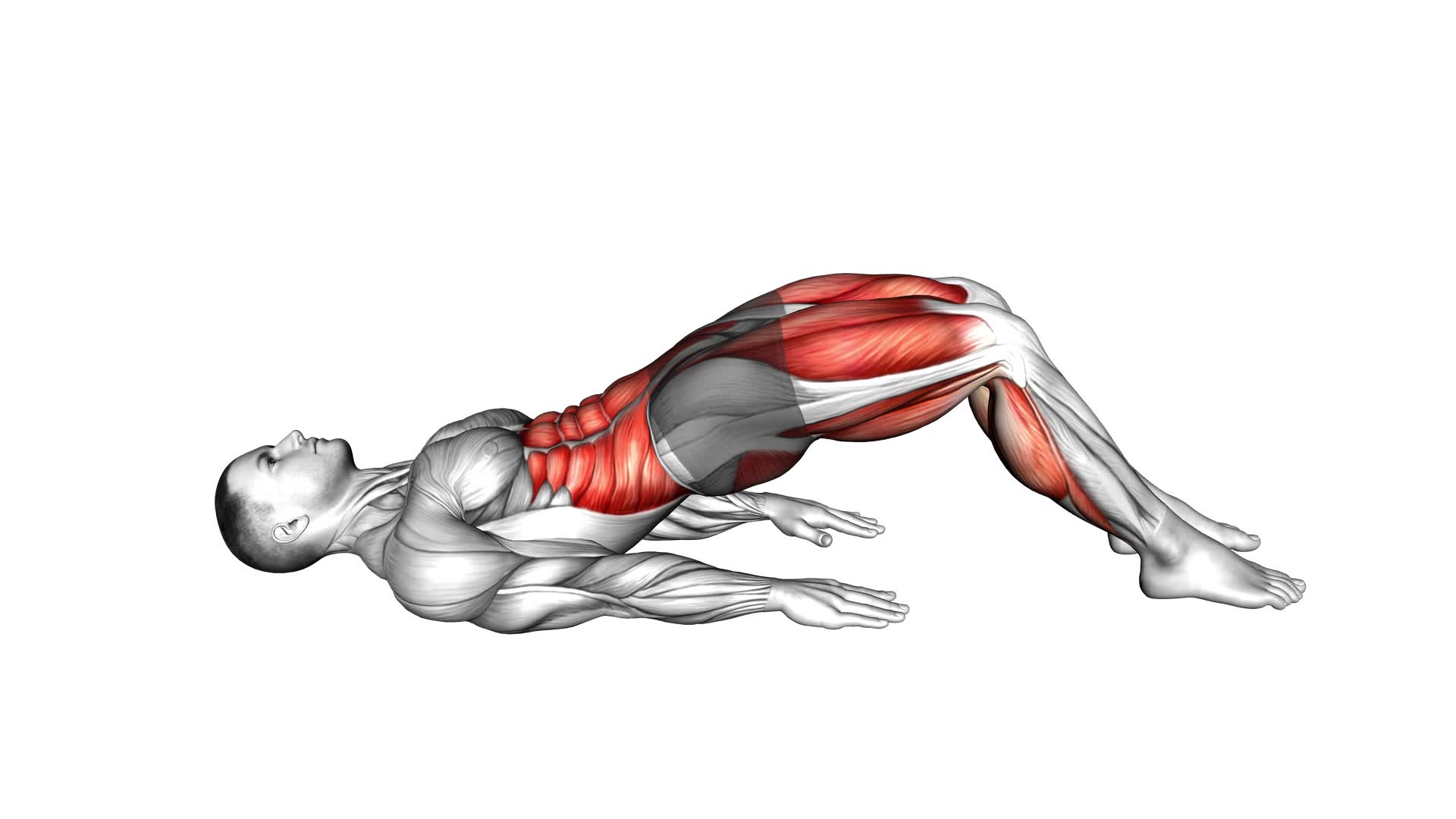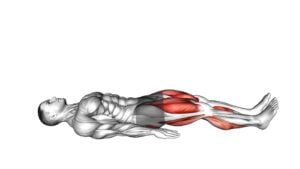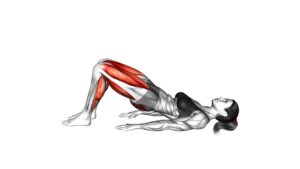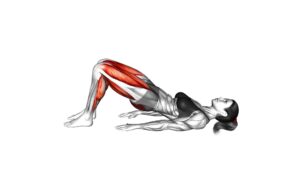Bridge Walk (male) – Video Exercise Guide & Tips

Are you looking for a quick and effective exercise routine? Look no further than the Bridge Walk!
Watch This Exercise Video
In this video exercise guide, we'll show you the proper form and technique for this male-targeted workout.
With variations and modifications to suit your fitness level, you can maximize your workout and achieve your fitness goals.
Avoid common mistakes and get ready to feel the burn.
Get ready to take your fitness to new heights with the Bridge Walk!
Key Takeaways
- The Bridge Walk exercise strengthens muscles and improves overall strength and stability.
- Proper form and technique are important for maximizing the benefits of the Bridge Walk, including maintaining a stable and aligned body position and engaging core muscles.
- The Bridge Walk targets glutes and hamstrings, improving balance, agility, and power, as well as enhancing lower body function and building strength and endurance.
- The Bridge Walk also offers cardiovascular health benefits, increasing heart rate, improving blood circulation, and enhancing cardiovascular endurance, reducing the risk of heart disease and improving overall cardiovascular fitness.
Benefits of the Bridge Walk
Discover the numerous benefits you can experience by incorporating the Bridge Walk into your exercise routine. Not only does this exercise strengthen your muscles, but it also provides various health benefits. The Bridge Walk is a great way to activate and engage your muscles, helping to improve overall strength and stability.
One of the key health benefits of the Bridge Walk is its ability to activate multiple muscle groups simultaneously. This exercise primarily targets the glutes, hamstrings, and core muscles. By engaging these muscles, you can improve your posture and lower back stability, reducing the risk of injury and enhancing your overall physical performance.
Muscle activation is a crucial aspect of any exercise routine, as it helps to build strength and endurance. The Bridge Walk specifically targets the glutes and hamstrings, which are essential for maintaining proper lower body function. Strengthening these muscles can improve your balance, agility, and power, allowing you to perform better in various physical activities.
In addition to muscle activation, the Bridge Walk also promotes cardiovascular health. By engaging multiple muscle groups, this exercise increases your heart rate, improving blood circulation and cardiovascular endurance. Regularly incorporating the Bridge Walk into your routine can help reduce the risk of heart disease and improve overall cardiovascular fitness.
Proper Form and Technique
To ensure proper form and technique during the Bridge Walk, focus on maintaining a stable and aligned body position.
This exercise is commonly performed incorrectly, so it's important to dispel some common misconceptions.
First, avoid arching your back excessively. While it's natural for a slight arch to occur, too much can strain your lower back. Instead, engage your core muscles to keep your spine neutral.
Another misconception is that the Bridge Walk primarily targets the glutes. While it does work your glutes, it also engages your hamstrings, quadriceps, and core muscles. So, make sure to distribute the effort evenly throughout your lower body.
Additionally, keep your feet shoulder-width apart and press through your heels to activate your glutes effectively.
If you find the Bridge Walk too challenging or want to switch things up, there are alternative exercises you can try. Some options include glute bridges, single-leg glute bridges, and hip thrusts. Experiment with these variations to continue challenging your muscles and progressing in your fitness journey.
Variations and Modifications
For a more challenging workout, try incorporating variations and modifications into your Bridge Walk routine.
These variations and modifications can help target different muscle groups and increase the intensity of your exercise.
One variation you can try is the single-leg bridge walk. Instead of lifting both legs off the ground, lift one leg at a time while maintaining the bridge position. This will engage your glutes and hamstrings even more.
Another variation is the weighted bridge walk. You can add a weight plate or dumbbell on your hips to increase resistance and make the exercise more challenging. This will help build strength in your lower body.
If you prefer a modification that reduces the intensity, you can try the mini bridge walk. Instead of lifting your hips all the way off the ground, only lift them halfway. This will still engage your glutes and core muscles but with less strain.
Remember to always listen to your body and choose variations and modifications that suit your fitness level and goals.
Tips for Maximizing Your Workout
How can you make the most of your Bridge Walk workout?
To maximize your workout, it's important to start with a proper warm-up. A warm-up prepares your muscles for exercise by increasing blood flow and flexibility. Spend at least five minutes doing light cardio exercises like jogging or jumping jacks before starting your Bridge Walk routine.
Incorporating resistance training into your Bridge Walk workout can also enhance its effectiveness. Resistance training helps build strength and muscle tone. You can use resistance bands or weights to add resistance to your Bridge Walk exercises. For example, you can hold a dumbbell in each hand while performing the Bridge Walk to challenge your muscles even more.
Remember to listen to your body and modify the workout as needed. If you experience any pain or discomfort, stop immediately and consult a healthcare professional. It's also important to stay hydrated throughout your workout and take breaks when necessary.
Common Mistakes to Avoid
Avoid these common mistakes when performing the Bridge Walk exercise. To ensure proper form and maximize the effectiveness of this exercise, it's important to pay attention to your technique.
One common mistake isn't engaging your core muscles. The Bridge Walk primarily targets the glutes and hamstrings, but neglecting to activate your core can put unnecessary strain on your lower back. Make sure to brace your abdominal muscles throughout the movement to maintain stability and protect your spine.
Another common mistake is lifting your hips too high. While it may seem like lifting your hips as high as possible will intensify the exercise, it actually takes away from the targeted muscle engagement. Instead, focus on lifting your hips to a level where your thighs and torso are in a straight line. This will ensure that the glutes and hamstrings are properly activated.
Additionally, avoid rushing through the exercise. Performing the Bridge Walk too quickly can lead to improper form and reduced muscle activation. Take your time and focus on each repetition, engaging the targeted muscles throughout the movement.
Frequently Asked Questions
How Long Should I Hold the Bridge Position During the Bridge Walk Exercise?
When doing the bridge walk exercise, it's important to know how long to hold the bridge position. Holding the bridge position for about 30 seconds is a good starting point.
This exercise has numerous benefits, such as strengthening your core, glutes, and hamstrings.
Additionally, there are variations of the bridge walk that you can try to make the exercise more challenging or target different muscle groups.
Can Bridge Walk Help in Improving My Posture?
Bridge Walk can be beneficial for improving your posture. By engaging your core muscles and stabilizing your spine, it helps to align your body properly.
This exercise also focuses on improving balance and increasing flexibility, which are important factors in maintaining good posture.
Regular practice of Bridge Walk can strengthen the muscles that support your spine, helping you to stand tall and maintain proper alignment throughout the day.
Is It Safe to Perform Bridge Walk if I Have Lower Back Pain?
If you have lower back pain, it may not be safe to perform the bridge walk exercise. It's important to prioritize your safety and avoid any movements that could exacerbate your pain.
However, there are alternative exercises that can help improve your posture without putting strain on your lower back. The bridge walk can be beneficial for strengthening the glutes, hamstrings, and core muscles.
Consider consulting with a healthcare professional for guidance on exercises suitable for your condition.
Can Bridge Walk Help in Strengthening My Core Muscles?
Bridge walk can be a great way to strengthen your core muscles. It targets the muscles in your abdomen, back, and hips, helping to improve stability and posture.
By engaging your core during bridge walk variations, you can increase the intensity and effectiveness of the exercise.
The benefits of bridge walk extend beyond just your core, as it also works your glutes, hamstrings, and quadriceps.
Incorporating bridge walk into your fitness routine can help you achieve a stronger and more balanced body.
Is It Possible to Incorporate Weights or Resistance Bands Into the Bridge Walk Exercise for Added Intensity?
Yes, you can definitely incorporate weights or resistance bands into the bridge walk exercise to add more intensity. Using weights during bridge walk can help to further strengthen your core muscles and increase overall muscle activation.
Resistance band variations for bridge walk can also provide added resistance, targeting different muscle groups in your body. By incorporating these additional tools, you can maximize the effectiveness of the bridge walk exercise and challenge yourself even more.
Conclusion
In conclusion, the bridge walk is a highly beneficial exercise that targets multiple muscle groups and improves core strength and stability.
By maintaining proper form and technique, you can maximize the effectiveness of this exercise.
Additionally, incorporating variations and modifications can provide added challenge and target specific muscle groups.
Remember to avoid common mistakes and follow the tips provided to ensure a safe and effective workout.
So lace up your sneakers and start incorporating the bridge walk into your fitness routine for optimal results.

Author
Years ago, the spark of my life’s passion ignited in my mind the moment I stepped into the local gym for the first time. The inaugural bead of perspiration, the initial endeavor, the very first surge of endorphins, and a sense of pride that washed over me post-workout marked the beginning of my deep-seated interest in strength sports, fitness, and sports nutrition. This very curiosity blossomed rapidly into a profound fascination, propelling me to earn a Master’s degree in Physical Education from the Academy of Physical Education in Krakow, followed by a Sports Manager diploma from the Jagiellonian University. My journey of growth led me to gain more specialized qualifications, such as being a certified personal trainer with a focus on sports dietetics, a lifeguard, and an instructor for wellness and corrective gymnastics. Theoretical knowledge paired seamlessly with practical experience, reinforcing my belief that the transformation of individuals under my guidance was also a reflection of my personal growth. This belief holds true even today. Each day, I strive to push the boundaries and explore new realms. These realms gently elevate me to greater heights. The unique combination of passion for my field and the continuous quest for growth fuels my drive to break new ground.



